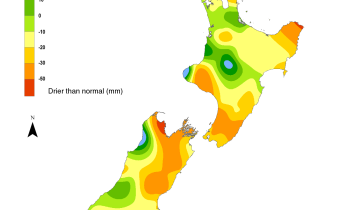A weekly update describing soil moisture patterns across the country to show where dry to extremely dry conditions are occurring or imminent. Regions experiencing significant soil moisture deficits are deemed “hotspots”. Persistent hotspot regions have the potential to develop into drought.
Facts: Soil Moisture
Heavy rainfall across several regions in the North Island and northern and eastern South Island led to serious flooding in some areas. Whangārei (64.4 mm) and Auckland/Māngere (56.6 mm) observed their wettest hours on record since at least 1979 and 1965, respectively. Parts of Auckland and Bay of Plenty received more than a month’s worth of rain in 10 hours on Monday and Wednesday, respectively. In addition, NIWA’s climate station in Gisborne recorded over 170% of the March monthly normal since Monday. Data from weather stations operated by Gisborne District Council shows that some locations received upwards of 500 mm of rain this week. Elsewhere in the North Island and northern and eastern South Island, weekly rainfall amounts generally exceeded 30 mm. Conversely, little if any rainfall fell in Otago and Southland. A weak front caused 1.8 mm of rain in Invercargill on Thursday morning, which has received just 35% of normal rainfall from December 2021 through March 2022 so far.
The rain resulted in substantial increases in soil moisture over the last week, with most of the North Island seeing a change from below normal to near normal or above normal. Soil moisture deficits also eased about the Tasman District in the South Island. However, dryness persisted or intensified in Southland, Otago, and parts of the West Coast. The driest soils across the North Island, when compared to normal for this time of the year, are found across the Firth of Thames. The wettest soils for the time of the year are found in east-coastal Northland, Auckland, Bay of Plenty, and Gisborne. The driest soils in the South Island, when compared to normal for this time of the year, are located in southern Southland and Stewart Island, while the wettest soils for the time of the year are found in northern Canterbury. Due to the heavy rainfall over the last week, all hotspots have eased in the North Island. In the South Island, hotspots are currently located along the south coast of Otago, much of southern Southland, and Stewart Island.
As of 22 March, the New Zealand Drought Index (NZDI) map below shows that dry or very dry conditions are located in coastal Otago and much of Southland. In addition, extremely dry conditions are located in coastal Southland and nearly all of Stewart Island, with meteorological drought continuing near Tiwai Point and in northern Stewart Island.
Outlook and Soil Moisture
In the North Island, persistent rainfall is possible over the next week across Gisborne, Hawke’s Bay, and Wairarapa. Weekly totals of 25-75 mm are possible. With soils already saturated in these areas, additional rainfall will prevent drying and in some cases may exacerbate flooding. Scattered rainfall across the remainder of the island will likely total 10 mm or less.
Soil moisture levels may decrease slightly in the western and northern North Island, but the redevelopment of hotspots looks unlikely.
In the South Island, widespread below or well below normal rainfall is forecast, with several regions likely to receive little or no measurable rainfall. Scattered showers about northern Canterbury and eastern Marlborough may total 5 mm or less.
Soil moisture levels are expected to decrease across most of the island. Importantly, hotspots in southern Otago, Southland, and Stewart Island will intensify and grow.
Looking further ahead, some rain is possible in the driest areas starting from around 1 April (Friday), although there is considerable uncertainty in the exact track of any possible low pressure system. Overall, the signal over the next month is for a continued reduction in rainfall about the lower South Island and Stewart Island.
Background:
Hotspot Watch: a weekly advisory service for New Zealand media. It provides soil moisture and precipitation measurements around the country to help assess whether extremely dry conditions are imminent.
Soil moisture deficit: the amount of water needed to bring the soil moisture content back to field capacity, which is the maximum amount of water the soil can hold.
Soil moisture anomaly: the difference between the historical normal soil moisture deficit (or surplus) for a given time of year and actual soil moisture deficits.
Definitions: “Extremely” and “severely” dry soils are based on a combination of the current soil moisture status and the difference from normal soil moisture (see soil moisture maps at https://www.niwa.co.nz/climate/nz-drought-monitor/droughtindicatormaps)
Hotspot: A hotspot is declared if soils are "severely drier than normal" which occurs when Soil Moisture Deficit (SMD) is less than -110 mm AND the Soil Moisture Anomaly is less than -20 mm.
Pictured above: Soil Moisture Anomaly Maps, relative to this time of year. The maps show soil moisture anomaly for the past two weeks.
New Zealand Drought Index (NZDI)
As of 22 March, the New Zealand Drought Index (NZDI) map below shows that dry or very dry conditions are located in Northland, Auckland, northern Waikato, western Bay of Plenty, coastal Otago, and much of Southland. In addition, extremely dry conditions are located in parts of coastal Southland and Stewart Island, with meteorological drought near Tiwai Point and in northern Stewart Island. With recent rainfall about the North Island, it is likely that NZDI values will ease over the coming week.
Please note: some hotspots in the text above may not correspond with the NZDI map. This difference exists because the NZDI uses additional dryness indices, including one which integrates the rainfall deficit over the past 60 days. Changes are therefore slower to appear in the NZDI compared to soil moisture anomaly maps that are instantaneously updated.










